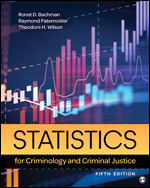Statistics for Criminology and Criminal Justice
- Ronet D. Bachman - University of Delaware, USA
- Raymond Paternoster
- Theodore H. Wilson - University at Albany, USA
A companion website for the book at edge.sagepub.com/bachmansccj5e includes resources for instructors and students.
Supplements
edge.sagepub.com/bachmansccj5e
For additional information, custom options, or to request a personalized walkthrough of these resources, please contact your sales representative.
LMS cartridge included with this title for use in Blackboard, Canvas, Brightspace by Desire2Learn (D2L), and Moodle
The LMS cartridge makes it easy to import this title’s instructor resources into your learning management system (LMS). These resources include:
- Test banks
- Editable chapter-specific PowerPoint® slides
- Answers to en-of-chapter problems from the book
- Software output for Excel, SPSS, and Stata organized by chapter
- Datasets for use with the book
You can still access all of the same online resources for this title via the password-protected Instructor Resource Site.
edge.sagepub.com/bachmansccj5e
The open-access Student Study Site makes it easy for students to maximize their study time, anywhere, anytime. It offers flashcards that strengthen understanding of key terms and concepts, datasets for use with the book, and software output for Excel, SPSS, and Stata organized by chapter.
I have used this book for a while. Good content, examples, and details for my grad students.

